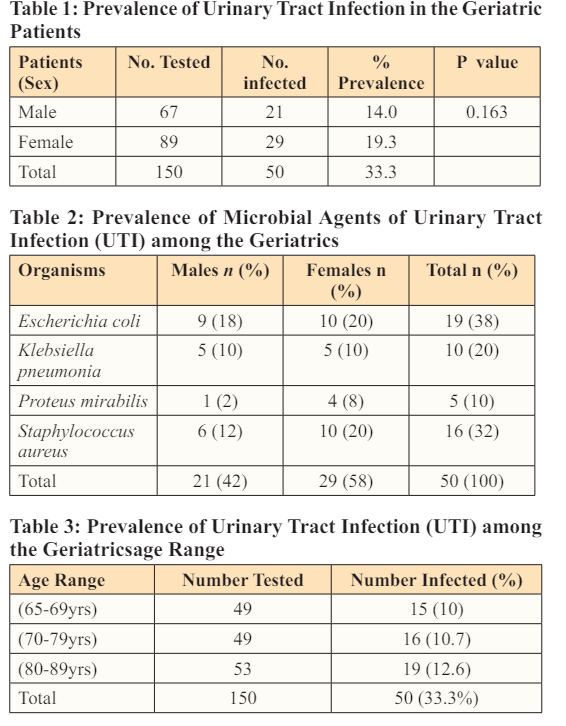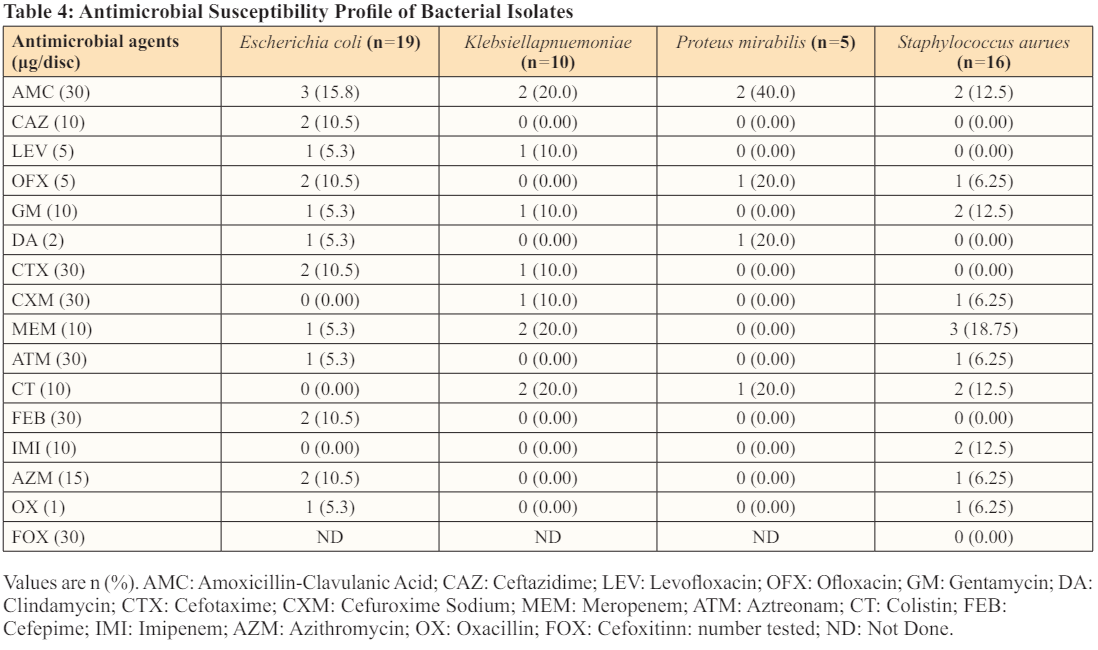Author(s): Onyemaechi Collins Micah*, Tombari Pius Monsi and Easter Godwin Nwokah
Urinary tract infections are one of the most prevalent infectious diseases presented in medical care facilities as well as community settings. The elderly have increased risk of developing urinary tract infection (UTI) with attendant morbidities and complications.This study was aimed at investigating the UTI prevalence of geriatric (≥65years) patients, their aetiological agents andantimicrobial susceptibility pattern. The study was conducted on urine samplesfrom150geriatric patients in PortHarcourt metropolis, Nigeria. The samples were inoculated onto MacConkey Agar and Cysteine Lactose Electrolyte Deficient (CLED) agar. Isolates were identified based on colonial morphology, Gram staining and Biochemical characterization and antimicrobial susceptibility test was performed on the bacterial isolates using Mueller-Hinton agar (Oxiod, United Kingdom) according to standard techniques. This study revealed that fifty 50 (33.3%) had UTI. The age group (80-89years) had the highest prevalence of UTI (12.6%) followed by (70years to 79years) which had (10.7%) and the lowest was (65years to 69years) with UTI prevalence of (10%). The bacterial isolates were poorly susceptible to all the antimicrobial agents used. Escherichia coli (38%) was the predominant bacterial uropathogen, followed by Staphylococcus aureus (32%), Klebsiella pnuemoniae (20%) and Protues mirabilis (10%) which had the lowest. In addition, this study revealed that the females had a higher prevalence of UTI (19.3%) than the males (14%). This study revealed that UTI in the geriatrics is a serious challenge in our locality. Extensive use of antibiotics in the geriatric have been implicated as likely reason for harboring resistant flora. Therefore, the rational use of antibiotics to is advocated to curtail the fast-rising increase of antimicrobial resistance and improve outcome.
Urinary tract infections (UTIs) are a common condition causing individuals to seek medical care. Among the populations at special risk for UTI are older adults [1]. UTI has been reported to be the second most common infection among older adults living in the community setting, as well as the leading site of infection in adults in long-term care facilities and has been implicated in the morbidity amongst older adults [2]. Among the population at high risk of urinary tract infections include the older adults. Long-term/prolonged catheterization in an elderly home care facility, misuse of antibiotics or other underlying factors such as low immunity of an aged individual, poverty, lack of adequate access to health care facility etc are some of the contributive factors predisposing the older adults to UTIs [2]. Escherichia coli is reported as the most prevalent pathogen causing UTI [1]. However, research reports carried out on geriatric in Benin city indicated that Staphylococcus aureus is the most prevalent organism [3]. There has also been an increase in the emergence of resistant uropathogens to antimicrobial agents among the elderly [2]. There is paucity of reports of UTI among the elderly in Port Harcourt metropolis. Therefore, this study aimed to determine the prevalence of UTI among the elderly as well as the aetiological agents and their antimicrobial susceptibility profiles.
A total of 150geriatric patients (≥ 65 years) with signs and symptoms of UTI were recruited for this study. The patients were attending the various clinics in Port Harcourt metropolis; Rivers State University Teaching Hospital, Nimi Briggs Hospital, Port Harcourt Homes of elderly and Rivers State University from the 1st May, 2022 to 31st October, 2022.Verbal informed consent was obtained from all patients prior to specimen collection. Approval for this study was given by the Rivers State Ministry of Health through the Ethical Committee of the Rivers State Hospital Management Board.
Clean-catch midstream urine was collected from each patient using boric acid as a preservative. A loopful (0.001 ml) of well-mixed urine was streaked on MacConkey agar and Cysteine lactose electrolyte deficient (CLED) media (Oxiod, United Kingdom). The plates were incubated aerobically for 24 hours and counts were expressed in colony forming unit (cfu) per milliliter (ml). A count of ≥105cfu/ml was considered significant to indicate UTI. Each urine sample (10ml) was centrifuged at 3000 rpm for 5 minutes. The supernatant was discarded and the deposit was examined microscopically at high magnification for pus cells, red blood cells, cast, epithelial cells, crystals, yeast-like cells. A count of pus cells ≥5 under high power field (x40objective) was considered
to indicate infection. The clinical isolates were identified by standard microbiological method [4]. The following sixteen (16) Antimicrobial-impregnated disk (Oxiod, United Kingdom) agents comprising (μg/disk) cefoxitin (30μg), ceftazidime (10μg), cefotaxime (30μg), cefuroxime (30μg), cefepime (30μg) gentamicin (10μg), clindamycin (2μg), azithromycin (15μg), amoxicillin-clavulanic acid (30ug), ofloxacin (5μg), oxacillin (1μg), levofloxacin (5μg), imipenem (10μg), meropenem (10μg), aztreonam (30μg), and colistin (10μg) were used for the antimicrobial susceptibility testing by modified Kirby-Bauer disk diffusion method. This was performed using bacterial suspension in physiological saline solution, with a turbidity matched to 0.5 on McFarland standard. The suspension was spread using a sterile swab stick to make for uniformity on a Mueller-Hinton agar (Oxiod, United Kingdom) and antimicrobial paper disc (Oxiod, United Kingdom) was used. Results were interpreted according to Clinical and Laboratory Standard Institution guidelines [5].
Statistical analysis was done using Graphpad Prism (version 8.02). Results were presented as Mean± SD. Chi-square, One-way ANOVA, P-value of ≤0.05 were accepted as significant results.
The prevalence of UTI was 33.3%. The female sex among the patients had a non-significantly higher prevalence of UTI than male, (p= 0.163) (Table 1). Escherichia coli was the most predominant causative agent in UTI among the geriatric patients, including both sexes of males and females with a prevalence of 38% (Table2). The prevalence of UTI increased with increasing age from 10% (65-69years) to 12.6% (80-89years), (p=0.494) (Table 3).


The elderly are at increased high risk of UTI, which is reported to be one of the most encountered infection in the community setting and long-term care facilities [6]. This study investigated the prevalence, aetiological agents, and the antimicrobial susceptibility profile of UTI among geriatric patients. This study revealed that 50 (33.3%) out of 150 patients had UTI, higher than previously reported by [7]. The females had higher prevalence of UTI 19.3% than males 14.0%, which is consistent with previous study reported by [8]. The reason for the higher prevalence of UTI in female patients may be due to the anatomical structure of the female reproductive system (close proximity of their urethra in the urinary tract). This study found that the prevalence of UTI increased with increasing age from 10% (65-69years) to12.6% (80-89years) and this may be due to immunological differences in the geriatric age and this is in agreement with previous reports [1]. We found that Escherichia coli (38%) were the most predominant isolates causing UTI in both sexes. This is in agreement with previous study reported although, it disagrees with some other study reported by [8, 9]. The reason for this disparity with previous report maybe because the findings were made on asymptomatic subjects, while this study finding was focused on symptomatic geriatric patients. The antimicrobial susceptibility profile showed poor susceptibility with more than 70% among most of the clinical isolates tested. We found that three of Enterobacteriaceae isolates were resistant to carbapenem (meropenem). Extensiveuse of antimicrobial agents in the geriatrics, as well as a poor functional immune status have been implicated as likely reasons for harboring resistant flora [10]. It is also notable that prescription of antibiotics without proper laboratory guidance, as well as counter sales of antibiotics without prescription are common practice in the Nigerian setting, and this has been suggested as the possible reason for the increased antibiotics resistance recently observed in the country according to [8]. Therefore, judicious use of antibiotics is advocated to curtail the fast-rising increase of antibiotic resistance and improve outcome.
In conclusion, an overall prevalence of 33.3% UTI among the geriatrics was observed. We found that female sex had a higher prevalence of UTI than male sex and the prevalence of UTI increases as age increases. Escherichia coli were the most prevalent isolates causing UTI. Proper use of antibiotics is advocated due to the poor antibacterial susceptibility profile.
